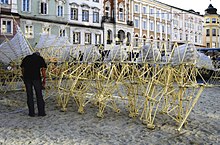Theo Jansen
Jump to navigation
Jump to search

Theodorus Gerardus Jozef "Theo" Jansen (born 14 March 1948) is a Dutch artist. In 1990, he began what he is known for today: building large mechanisms out of PVC that are able to move on their own, known only as Strandbeest.
Quotes[edit]
- The walls between art and engineering exist only in our minds, and few go beyond them.
- In advert for BMW, as cited in: Herman van den Broeck, David Vente. Beyonders: transcending average leadership. (2011). p. 52.
- Since 1990 I have been occupied creating new forms of life. Not pollen or seeds but plastic yellow tubes are used as the basic material of this new nature. I make skeletons that are able to walk on the wind, so they don’t have to eat. Over time, these skeletons have become increasingly better at surviving the elements such as storm and water and eventually I want to put those animals out in herds on the beaches so they will live their own lives.
- Theo Jansen at streamingmuseum.org, 2014.
- Kinetic art was created by artists who pushed the boundaries of traditional, static art forms to introduce visual experiences that would engage the audience and profoundly change the course of modern art.
- Theo Jansen, quoted in: "2015 International Kinetic Art Exhibit & Symposium - Boynton Beach, FL, USA," 2015
The Great Pretender. (2007)[edit]

- In the Pregluton, there were no animals of plastic tubing yet. This initial period was marked by an absence of matter. Life then consisted exclusively of dreaming about life.
- p. 9 ; Paragraph "Memory in reverse"
- I made virtual animals in the computer, life-forms subject to an artificial evolution. I also went walking a lot on the beach and in the streets of Scheveningen for inspiration for my columns. Since 1986 I have been writing pieces for de Volkskrant national daily on matters that interest me. Often these are technical things, fantasies or musings.
- p. 9
- The anatomy of self-propelling objects is subject to universal laws. Those of cars and animals are similar in many ways. First of all, there's the stomach. Stomachs are like petrol tanks. It takes energy to move around, and that energy must accompany its user. All self-propelling objects carry provisions with them in a sealed-off space, a stomach or a tank. Self-propelling beach animals like Animaris Percipiere have a stomach too. This consists of recycled plastic bottles containing air that can be pumped up to a high pressure by the wind.
- p. 153
Quotes about Theo Jansen[edit]
- In "The Great Pretender," kinetic artist Theo Jansen shows that the concept of 'I' is merely a tool in our evolution. We need this tool to be selfish. There can be no selfishness without the I-fantasy.
Since 1990, Theo Jansen has been engaged in creating new forms of life: beach animals made from yellow plastic tubing. Skeletons made from these tubes are able to walk, deriving their nutrition from the wind. They evolved over many generations, becoming increasingly adept at surviving storms and water from the sea. Theo Jansen's ultimate wish is to release herds of these animals on the shore. In reenacting Genesis, so to speak, he hopes to become wiser in his dealings with the existing nature by encountering problems the 'creator' had to face. "The Great Pretender" is a account of Jansen's experiences as God.- Theo Jansen, The Great Pretender. (2007), Text back cover.
